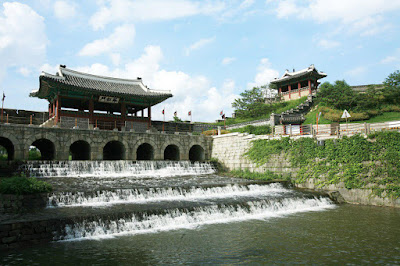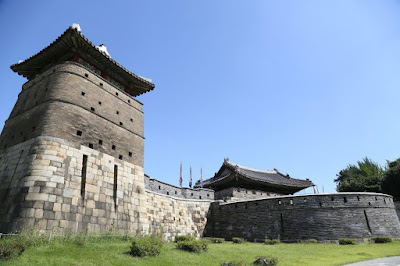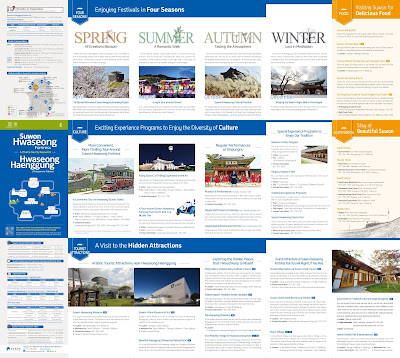Suwon Hwaseong Fortress was constructed by king Jeongjo (reigning 1777~1800), the 22nd king of Joseon dynasty (1392-1910) after moving the tomb of his father Sadoseja, Crown Prince, who had been victimized in faction struggles in the court, and put inside a rice chest and had died in it, from Mt. Baebong, Yangju, to Mt. Hwa, Suwon. and the moving of the local government headquarters from near Mt. hwa to the current location under Mt. Paldal, Suwon. The mountain was considered as the best place to build tombs according to the theory of geomancy in those days.
There were multiple reasons for constructing the Suwon Hwaseong Fortress. The most important reason was King Jeongjo's filial piety to his father. But, there were other reasons: his political strategy to eradicate faction struggles and establish the king-led politics; use of it as a fortress of national defense to the south.
Using Seonghwajuryak (1793) written by Jeong Yak Yong, government official at Gyujanggak, referring to technology books of the East and the West as the guidebook, the fortress started to be constructed in January 1794, and was completed in September 1796 under the general supervision of Chae Jae Gong, former prime minister and then yeongjungchubusa, and the direction of Jo Sim Tae.
In the process of constructing it, new machines like geojunggi and nokro was specifically designed to move and pile up big stones. When the fortress was built, many subsidiary facilities such as Hwaseong Haenggung, Jungposa, Neposa, and Sajikdan, etc. were also built. But, most of them have been destroyed in later wars and riots, except for Naknamheon, part of Hwaseong Haenggung. Passing though the Japanese Occupation Era (1910~1945), and the Korean War (1950~1953), parts of the fortress were destroyed or lost. But, during the period of 1975~1979, most of the destroyed or lost parts were repaired and recovered, referring to Hwaseong Seongyeok Euigwae.
The circumference of the fortress is 5,744m, and its area is 130ha. It is a pyeongsanseong, or flat and mountainous fortress, with its eastern part flat, and its western part straddling Mt. Paldal. There were originally 48 facilities in the fortress: 4 munru, gate tower; 2 sumun, watergate; 3 gongsimdon, gun-shooting tower; 2 jangdae; 2 nodae, arrow-shooting towers; 5 poru, tower on the wall; 4 gakru; 5 ammun, open gate on the wall; 1 bongdon, or beacon tower, 4 jeokdae, watchtower; 9 chiseong, protective facilities on the wall; and 2 eungu. Among them, 7 facilities have disappeared by floods or wars, and 41 remain intact.
The fortress walls of Suwon Hwaseong remain intact almost as the original form as it was constructed 200 years ago. The Suwoncheon River, which flowed through Buksumun (or Hwahongmun) watergate, still flows through the watergate, and the road network linking Paldalmun, Janganmun, Hwaseong Haenggung, and Changrongmun are still used as an important part of the road network of current Suwon city. The construction of the fortress was motivated by political and economic purposes as well as the filial piety of the king to his father, rather than by military one. Thus, the fortress can be said to symbolize "hyo," filial piety, part of East Asian philosophy, and so it has spiritual and philosophical value, in addition to cultural one.
Especially, the fortress, the result of the fortress construction technologies of the East and the West based on sufficient researches and meticulous plans, is very important in the respect of architectural history. Hwaseong Seongyeok Euigwae published in 1801 after the fortress had been completed provides detailed descriptions about personal informations of those workers who participated in the project, sources and uses of various materials, calculation of budgets and wages, various machines used, the methods of processing materials, and construction diary, as well as the blueprint of construction, and related institutions and rules. So, the book is evaluated as having left an important footprint in architectural history, specifically on fortress building, and having a big historical value as records themselves.
The Suwon Hwaseong Fortress was designated as the Historical Remains No. 3, and has been managed as such. As subsidiary cultural assets, it has Paldalmon gate (Treasure No. 402), Hwaseomun gate (Treasure No. 403), Janganmun gate, and Gongsimdon, etc. The Suwon Hwaseong Fortress was chosen to be registered as an UNESCO World Heritage in December 1997.
Viewing Hours
Summer Season(March~October) : 09:00~18:00
Winter Season(November~February) : 09:00~17:00
Suwon Hwaseong Fortress is operated in throughout the year and Suwon Hwaseong Fortress is no limit in visiting hours. But from 9:00am to 6:00pm(Winter Seaseon 5:00pm), there's entrance fee. After 6:00pm((Winter Seaseon 5:00pm), you may enter Suwon Hwaseong Fortress free of charge.
Price
Adults 1,000won / Youth 700won / Children 500won
Information on Transportation






















